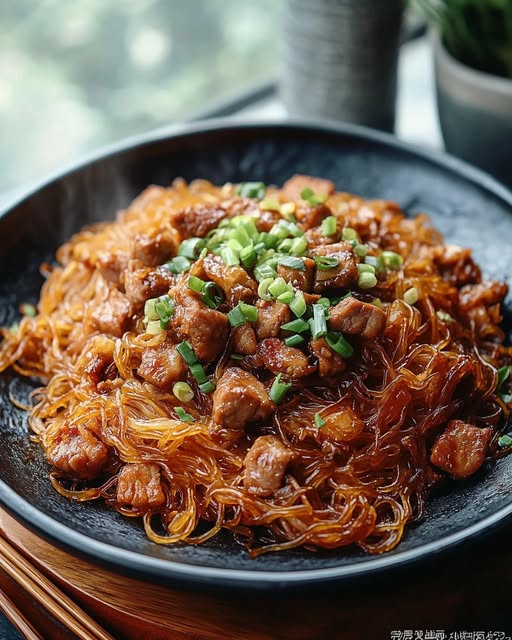Ever had one of those evenings where you crave something quick, flavorful, and comforting? That’s exactly when I turn to Spicy Beef Vermicelli, also known as Ma Yi Shang Shu (蚂蚁上树). This classic Sichuan dish is a lifesaver for busy weeknights. Imagine tender mung bean noodles braised in a rich, spicy sauce with savory beef. It’s like a warm hug for your taste buds, served over steaming rice. Let me tell you why this dish has become my go-to recipe!
A Taste of Sichuan: The Story Behind Spicy Beef Vermicelli
Ma Yi Shang Shu, which translates humorously to “ants climbing a tree,” gets its name from how the minced beef clings to the vermicelli noodles. Don’t worry—it’s not actual ants! This dish hails from the Sichuan province, famous for bold flavors and fiery spices. Traditionally, it’s made with doubanjiang, a fermented chili bean paste that gives the dish its signature kick. I first tried this dish at a local Chinese restaurant, and it blew me away. When I recreated it at home, my family couldn’t stop raving about it. Trust me, once you try it, you’ll understand why it’s a timeless favorite.
Why You’ll Love This Recipe
This Spicy Beef Vermicelli recipe is perfect for anyone who loves bold flavors without spending hours in the kitchen. The combination of spicy, savory, and slightly sweet elements creates a symphony of taste. Plus, it’s adaptable! You can tweak the spice level or make it gluten-free by swapping sauces. The best part? It’s ready in just 20 minutes. Whether you’re cooking for yourself or feeding a crowd, this dish delivers every time.
Perfect Occasions to Prepare This Dish
Need a quick dinner after a long day? This dish is your answer. It’s also great for casual dinners with friends or family gatherings. I’ve served it during game nights, potlucks, and even holiday meals. Everyone loves how the noodles soak up the flavorful sauce, making each bite irresistible. It’s versatile enough to fit any occasion but special enough to impress.
Ingredients
- 110 g of dried mung bean vermicelli
- 1 tablespoon peanut oil or vegetable oil
- 1 tablespoon thinly sliced ginger
- 2 cloves garlic, minced
- 2 green onions, sliced
- 1 tablespoon doubanjiang (fermented chili bean paste)
- 120 g ground beef
- 120 ml chicken broth or water
- Sauce:
- 1 tablespoon light soy sauce
- 1 teaspoon dark soy sauce
- 1 tablespoon Shaoxing wine or dry sherry
- 1 teaspoon sugar
Substitution Options
If you don’t have all the ingredients on hand, no worries! Here are some swaps:
- Use rice noodles instead of mung bean vermicelli if needed.
- Replace ground beef with turkey, chicken, or tofu for a vegetarian twist.
- Swap doubanjiang with regular chili paste, though the flavor will be slightly different.
- Use tamari instead of soy sauce for a gluten-free version.
Preparation Section
Step 1: Soak the Vermicelli
Start by soaking the dried vermicelli in hot water. Follow the package instructions, or soak them for about 15 minutes if none are provided. Once softened, drain well and toss with half a tablespoon of oil to prevent sticking. This step ensures the noodles cook evenly later. Pro tip: Keep an eye on the texture—over-soaking can make them mushy.
Step 2: Prepare the Sauce
In a small bowl, whisk together the light soy sauce, dark soy sauce, Shaoxing wine, and sugar. This sauce mix brings balance to the dish, enhancing both sweetness and umami. Set it aside for now. Chef’s tip: Taste the sauce before adding it to the dish. Adjust the sugar or soy sauce based on your preference.
Step 3: Sauté Aromatics
Heat half a tablespoon of oil in a nonstick skillet over medium heat. Add the ginger, garlic, and green onions. Stir-fry for 30 seconds until fragrant. The aroma will fill your kitchen, making everyone curious about what’s cooking. Be careful not to burn the garlic—it can turn bitter quickly.
Step 4: Cook the Beef
Add the ground beef to the skillet. Break it apart with your spatula and cook until browned, about 2 minutes. The beef should crumble into small pieces, resembling the “ants” in the dish’s name. Make sure there’s no pink left, as undercooked meat can ruin the dish.
Step 5: Add Doubanjiang
Stir in the doubanjiang and mix well to coat the beef. Cook for another minute to deepen the flavors. This step is crucial because the fermented paste adds a complex spiciness that defines the dish. Pro tip: If you’re sensitive to spice, start with half a tablespoon and adjust as needed.
Step 6: Combine Everything
Pour in the chicken broth, soaked vermicelli, and prepared sauce. Stir everything together, then cover and cook for 2–3 minutes. Uncover, stir again, and check the noodles’ tenderness. If they’re still firm, cover and cook for another minute. Once done, crank up the heat to evaporate excess liquid. Finish with a drizzle of toasted sesame oil if desired—it adds a nutty aroma that ties everything together.
Timing
Here’s a quick breakdown of the timing:
- Prep Time: 15 minutes
- Cook Time: 5 minutes
- Total Time: 20 minutes
This speedy timeline makes it ideal for busy days.
Chef’s Secret
To take this dish to the next level, toast the vermicelli lightly in a dry pan before soaking. This step enhances their nutty flavor and gives the noodles a slightly chewier texture. Your guests won’t know what hit them!
Extra Info
Did you know that doubanjiang dates back over 200 years? It’s considered the soul of Sichuan cuisine. Its unique fermentation process creates a depth of flavor unmatched by other condiments. Try making this dish with homemade doubanjiang sometime—it’s worth the effort!
Necessary Equipment
You’ll need:
- A large mixing bowl for soaking the noodles
- A nonstick skillet or wok
- A spatula for stirring
- Measuring spoons and cups
Simple tools, big results!
Storage
Short-Term Storage: Store leftovers in an airtight container in the fridge for up to 3 days. Reheat gently on the stovetop or microwave, adding a splash of water to revive the sauce.
Freezing: Freeze portions in freezer-safe bags for up to 2 months. Thaw overnight in the fridge before reheating. Note that the texture of the noodles may change slightly after freezing.
Reviving Leftovers: To bring back the dish’s original vibrancy, sprinkle a bit of fresh green onion or sesame oil before serving. It makes a world of difference!
Tips and Advice
– Always taste the sauce before adding it to the dish. Adjust seasonings as needed.
– Don’t skip soaking the noodles—they won’t cook properly otherwise.
– Use high-quality doubanjiang for the best flavor. Cheap substitutes can lack depth.
Presentation Tips
- Garnish with chopped green onions for color contrast.
- Serve in shallow bowls with steamed rice on the side.
- Add a sprinkle of crushed peanuts for crunch.
Healthier Alternative Recipes
Want to lighten up this dish? Try these variations:
- Veggie-Packed Version: Add shredded carrots, bell peppers, or spinach for extra nutrients.
- Low-Sodium Option: Use low-sodium soy sauce and reduce the salt content.
- Lean Protein Swap: Replace beef with ground turkey or chicken breast.
- Gluten-Free Twist: Use tamari instead of soy sauce and ensure all other ingredients are GF-friendly.
- Plant-Based Delight: Substitute beef with crumbled tofu or tempeh.
- Lite Spice Kick: Cut down on doubanjiang and add a dash of red pepper flakes instead.
Common Mistakes to Avoid
Mistake 1: Overcooking the Noodles
Overcooked vermicelli turns mushy and loses its texture. To avoid this, soak them just until tender and finish cooking briefly in the skillet. Pro tip: Test the noodles frequently while simmering to ensure they retain a slight bite.
Mistake 2: Skipping the Sauce Balance
The sauce needs harmony between salty, sweet, and umami flavors. Tasting it beforehand helps you adjust ratios. Without proper balance, the dish might feel flat.
Mistake 3: Burning the Garlic
Burnt garlic tastes bitter and ruins the dish. Keep the heat moderate and stir constantly while sautéing aromatics. Lower the flame if needed.
Mistake 4: Using Low-Quality Doubanjiang
Cheap doubanjiang lacks the complexity of premium versions. Invest in a good brand—it makes a noticeable difference.
FAQ
What is Ma Yi Shang Shu?
Ma Yi Shang Shu, or Spicy Beef Vermicelli, is a traditional Sichuan dish featuring mung bean noodles cooked in a spicy sauce with ground beef. Its name comes from the way the beef clings to the noodles, resembling ants climbing a tree.
Can I make this dish vegetarian?
Absolutely! Swap the beef for tofu or mushrooms and use vegetable broth instead of chicken broth. The result is equally delicious.
Is doubanjiang spicy?
Yes, doubanjiang contains chili peppers, so it adds heat to the dish. However, you can control the spiciness by adjusting the amount used.
How do I store leftovers?
Store leftovers in an airtight container in the fridge for up to 3 days. Reheat gently on the stovetop or microwave, adding water if needed.
Can I freeze this dish?
Yes, freeze portions in freezer-safe bags for up to 2 months. Thaw overnight in the fridge before reheating.
What can I serve with this dish?
Serve it with steamed white or brown rice for a complete meal. A side of stir-fried veggies complements it nicely too.
Do I need special equipment?
No fancy gadgets required! Just a skillet, spatula, and basic kitchen tools will do.
Can I use fresh noodles?
Fresh noodles work, but they require less soaking time. Check the packaging for guidance.
How can I adjust the spice level?
Reduce the amount of doubanjiang or omit it entirely. Add mild chili flakes for a gentler kick.
Where can I find doubanjiang?
Look for doubanjiang in Asian grocery stores or online retailers. Choose a reputable brand for the best flavor.
Final Thoughts
Spicy Beef Vermicelli is more than just a dish—it’s a celebration of bold flavors and simple cooking. With its quick prep time and adaptability, it’s perfect for busy evenings or casual gatherings. Whether you stick to the classic recipe or experiment with healthier twists, this dish promises to satisfy. So grab your ingredients, fire up the stove, and let’s get cooking!

Spicy Beef Vermicelli
Ingredients
Equipment
Method
- Soak the dried vermicelli in hot water for about 15 minutes or as per package instructions, then drain and toss with half a tablespoon of oil.
- In a small bowl, whisk together the light soy sauce, dark soy sauce, Shaoxing wine, and sugar; set aside.
- Heat half a tablespoon of oil in a nonstick skillet over medium heat and sauté ginger, garlic, and green onions for 30 seconds until fragrant.
- Add the ground beef, breaking it apart with a spatula, and cook until browned, about 2 minutes.
- Stir in the doubanjiang and cook for another minute.
- Pour in the chicken broth, soaked vermicelli, and prepared sauce; stir, cover, and cook for 2–3 minutes, adjusting for noodle tenderness as needed.
- Increase the heat to evaporate excess liquid and finish with a drizzle of toasted sesame oil if desired.
